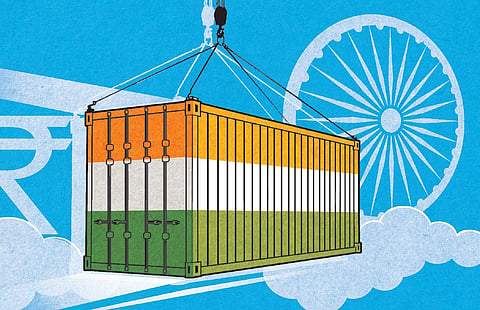

In the vast expanse of India’s development story, one thread stands out as a beacon of progress and hope—the monumental transformation of its infrastructure—ushered in by the BJP-led NDA government under the visionary leadership of Prime Minister Narendra Modi. Through a strategic focus on HIRA—Highways, Internet Ways, Railways and Airways—India has witnessed a paradigm shift in its infrastructure landscape. Sound and well-planned infrastructure is key to a nation’s economic prosperity.
As US President John F Kennedy once remarked, “American roads are not good because America is rich, but America is rich because American roads are good.” While India has moved from being the 10th largest economy in the world to the fifth largest economy, the country should be on track to realise Modi’s vision of becoming a $5 trillion economy by 2027 and a Viksit Bharat by 2047.
To achieve this, robust infrastructure is paramount, serving as the lifeline for economic activities and industrial growth. Whether it’s the expansion of highways, modernisation of railways, development of waterways, or advancement of airways, every aspect contributes to India’s journey towards prosperity.
The National Infrastructure Pipeline (NIP), introduced in 2019, emphasises social and infrastructure projects including energy, roads, railways and urban development projects worth Rs 102 lakh crore. NIP is complemented by the PM Gati Shakti Master Plan, which aims to provide infrastructure for multi-modal connectivity to various economic zones, combining information about major infrastructure from both central and state governments into a Geographic Information System (GIS)-enabled platform for seamless planning, designing, and monitoring.
The National Logistics Policy (NLP) announced in 2022 formalises this approach and aims to reduce the logistics cost in India to under 10 per cent and make us one of the top 25 countries in the world in the Logistics Performance Index ranking. Under the NLP, the BJP-led NDA government has launched the Unified Logistics Interface Platform (ULIP) to provide all digital services related to the transportation sector into a single portal, creating a single-access point for all.
Take another example of Krishi Udan Scheme, an initiative launched to help farmers transport their perishable goods. This showcases the importance of infrastructure for helping realise the vision of doubling farmers’ income. Likewise, the Ministry of Shipping under the Sagarmala programme is developing an inland waterways network throughout the country under the PPP model.
Be it the Nhava Sheva Atal Setu, which is the longest sea bridge in India, or Jammu and Kashmir’s Chenab bridge, which is taller than the Eiffel Tower and the world’s highest single-arch railway bridge, or India’s first underwater metro in Kolkata—India’s infrastructure is touching heights that were unimaginable before.
Similarly, in today’s digital age, the significance of digital infrastructure cannot be overstated. From seamless internet connectivity to widespread mobile penetration, India has made significant strides in bridging the digital divide. The rise of cloud kitchens and online businesses exemplifies how connectivity and technology have empowered entrepreneurs and transformed traditional business models.
Moreover, India’s push towards digital infrastructure has led to groundbreaking initiatives like the JAM trinity—Jan Dhan, Aadhaar, and Mobile. This integration of banking services, digital identity and mobile connectivity has revolutionised financial inclusion. More than 50 crore people have benefited from Jan Dhan Yojana, with Jan Dhan account holders depositing over Rs 2 lakh crore in these accounts. India has so far issued 135 crore Aadhaar identities and has around 80 crore active mobile users. Fintech is proving to be very useful in taking banking towards far-flung, remote and tribal areas.
Initiatives like Micro-ATMs are examples of that. These initiatives have led to 13.5 crore people coming out of poverty in the last few years. As per data published by TRAI, internet penetration in India as of March 2023 is over 88 crore, and the number of telecom subscribers as of March 2023 is over 117 crore. Between 2019-2021, 9.5 crore internet subscribers were added in rural areas as compared to 9.2 crore in urban areas.
Studies by the RBI estimate that for every rupee spent on infrastructure, there is a 2.5 to 3.5 rupee gain in GDP. With critical infrastructure upgrades and a rise in per capita income, India moves closer to realising its aspiration of becoming Viksit Bharat by 2047.
Sumeet Bhasin
Director, Public Policy Research CentreI
Posts on X (formerly known as Twitter): @sumeetbhasin